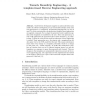828 search results - page 3 / 166 » A New Model of Program Dependences for Reverse Engineering |
IWPC
2006
IEEE
14 years 1 months ago
2006
IEEE
Software systems are often written in more than one programming language. During development, programmers need to understand not only the dependencies among code in a particular l...
IEEEIAS
2007
IEEE
14 years 1 months ago
2007
IEEE
An obfuscation aims to transform a program, without affecting its functionality, so that some secret data within the program can be hidden for as long as possible from an adversar...
KI
2004
Springer
14 years 1 months ago
2004
Springer
In this paper we present a new model of Java programs. We show how a program can be compiled into the model. The model can be directly used by a model-based diagnosis engine in ord...
ECMDAFA
2008
Springer
13 years 9 months ago
2008
Springer
Model driven development suggests to make models the main artifact in software development. To get executable models in most cases code generation to a "traditional" prog...
KBSE
1997
IEEE
13 years 11 months ago
1997
IEEE
Given a program S and a precondition Q, the strongest postcondition, denoted sp(S Q), is defined as the strongest condition that holds after the execution of S, given that S term...

